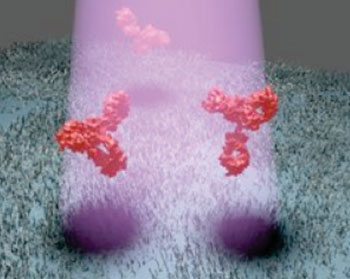Laser Scattering Technique Detects Single Molecules
By LabMedica International staff writers
Posted on 22 Sep 2014
A recent paper described a novel technique for the label-free detection of single biomolecules such as tumor markers, proteins, or RNA fragments.Posted on 22 Sep 2014
Investigators at the Max Planck Institute for the Science of Light (Erlangen, Germany) adapted a method called interferometric detection of scattering (iSCAT) to achieve the goal of label-free single molecule detection.

Image: Investigators identified individual unlabeled proteins by the weak shadow that the biomolecules produce when they scatter laser light (Photo courtesy of the Max Planck Institute for the Science of Light).
In this approach, which was described fully in the July 29, 2014, online edition of the journal Nature Communications, the investigators directed laser light onto a microscope slide on which proteins of interest had been captured with appropriate biochemical lures. The bound proteins scattered the laser light, thus casting a shadow. By comparing shadow diagrams before and after binding of the proteins of interest, the investigators could identify target proteins, which stood out clearly from the background as dark spots, even though the shadow of the protein was only one ten-thousandth or even one hundred-thousandth as dark as the background.
“In our method the scattering image of a protein is amplified and stripped of background noise. iSCAT not only promises more sensitive diagnosis of diseases such as cancers, but will also shed light on many fundamental biochemical processes in nature,” said senior author Dr. Vahid Sandoghdar, director of the nano-optics division of the Max Planck Institute for the Science of Light. “Until now it was thought that if you want to detect scattered light from nanoparticles, you have to eliminate all background light. However, in recent years we have realized that it is more advantageous to illuminate the sample strongly and visualize the feeble signal of a tiny nanoparticle as a shadow against the intense background light. The strength of our method lies not only in the fact that it is so sensitive and that we can count target proteins in a sample, iSCAT also shows us the exact position of particles.”
Related Links:
Max Planck Institute for the Science of Light













